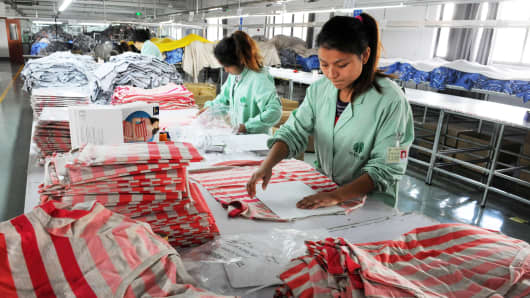At the bustling Canton Fair in southern China, second-generation textile manufacturer Pan Jing has drastically marked down her prices.
The sign at her booth says it all: "Stock very cheap, factory for sale ... stock clearance."
It wasn't an easy decision for Pan's family to sell the 32-year-old cotton mill started by her father in 1986, a time when China was emerging as the global centre for textile and clothing production.
More from the South China Morning Post:
How ethical fashion is growing in Asia-Pacific and five sustainable clothing brands to watch
Five years since the nightmare of Rana Plaza, what changed for Bangladesh garment workers?
Can Chinese manufacturers ever be clean, green and profitable? Garment factories search for the answer
For years, they have been making household cotton products – from pot holders and oven mitts to dishcloths and towels – and exporting them to the United States and Europe.
More recently they tried to upgrade their product lines at the 40,000 sq m factory in the southern Guangxi region, adding recycled cotton shopping bags and pillows in the shape of emojis in a bid to bring in more customers. But rising labor costs and slow growth in overseas demand left Pan with no choice but to sell the business to a bigger textile manufacturer with a domestic focus, in the hope that new capital can keep it afloat.
"I don't see a future in continuing to sell these low-value goods," said Pan, who has been attending the Guangzhou fair for over a decade. The trade fair, which runs until May 5, is the country's oldest and biggest export-oriented event.
China's textile and apparel makers are going through a painful industrial restructuring. While the country is still the world's largest clothing exporter with enormous production capacity, oversupply at home, high labour costs, and rising global protectionism have all eroded its competitiveness.
Pan's company brochures for the trade fair over the years reflect the changes in the industry. Six years ago, the tag line was "To be proud of Made-in-China", while last year's was "Low-carbon and environmentally friendly cyclical development". This year they just had a flier made to advertise the stock clearance.
China's market share by value in the global textile and clothing industry fell from 38.6 per cent in 2015 to 35.8 per cent in 2016, with a downward trend in major apparel importing regions such as the US, European Union and Japan.
Since 2014, exports of Chinese textiles and clothing have declined sharply from about US$236 billion in 2014 to US$206 billion in 2016, according to the World Trade Organisation.
Chinese customs data showed exports of clothes and accessories fell by 0.4 per cent last year from 2016, while textiles exports saw annual growth of 4.5 per cent last year.
Meanwhile, labour costs in China have been rising steadily. The minimum wage in the southern boomtown of Shenzhen is now about US$336 per month – more than double the rate in some Southeast Asian countries.
Hit by the industry restructuring, some of the big clothing brands have struggled to make a profit and secure finance. Revenues have been sliding at Fuguiniao, a Hong Kong-listed menswear and shoe manufacturer based in Fujian province, since 2015. The company had a net loss of 10 million yuan (US$1.57 million) in the first half of last year, a bond default this year, and it has racked up debts of at least 3 billion yuan.
Although analysts say Chinese textile and clothing makers are at low risk from the looming trade war between China and the US, given that they export so little to America compared to other sectors, US brands are starting to diversify their sourcing.
A survey of 34 executives from leading US fashion companies last year found that, for the first time, fewer US brands were looking to China for products, even though the country remains the top sourcing destination for the industry worldwide.
"US fashion companies are not 'putting all their eggs in one basket', and the most common sourcing model is shifting from 'China plus many' to 'China plus Vietnam plus many,'" according to the US Fashion Industry Association, which conducted the survey.
For many US brands, a third of their products now come from China, a third from Vietnam, and the rest is from other countries, the survey found.
But Sheng Lu, assistant professor of fashion and apparel studies at the University of Delaware, said "made in China" products were not losing their price competitiveness because of the overall supply chain efficiency.
"It is also important to recognise that China is playing an increasingly important role as a textile supplier for apparel exporting countries in Asia," Sheng said.
According to Sheng's research, Bangladesh's textile imports from China, measured by value, rose from 39 per cent in 2005 to 47 per cent in 2015, and similar trends could be seen in Cambodia, Vietnam, Malaysia and other developing countries in Asia.
"A meaningful indicator to watch in the future is the value of "made in China" goods within other Asian countries' clothing exports to the world," he said.


